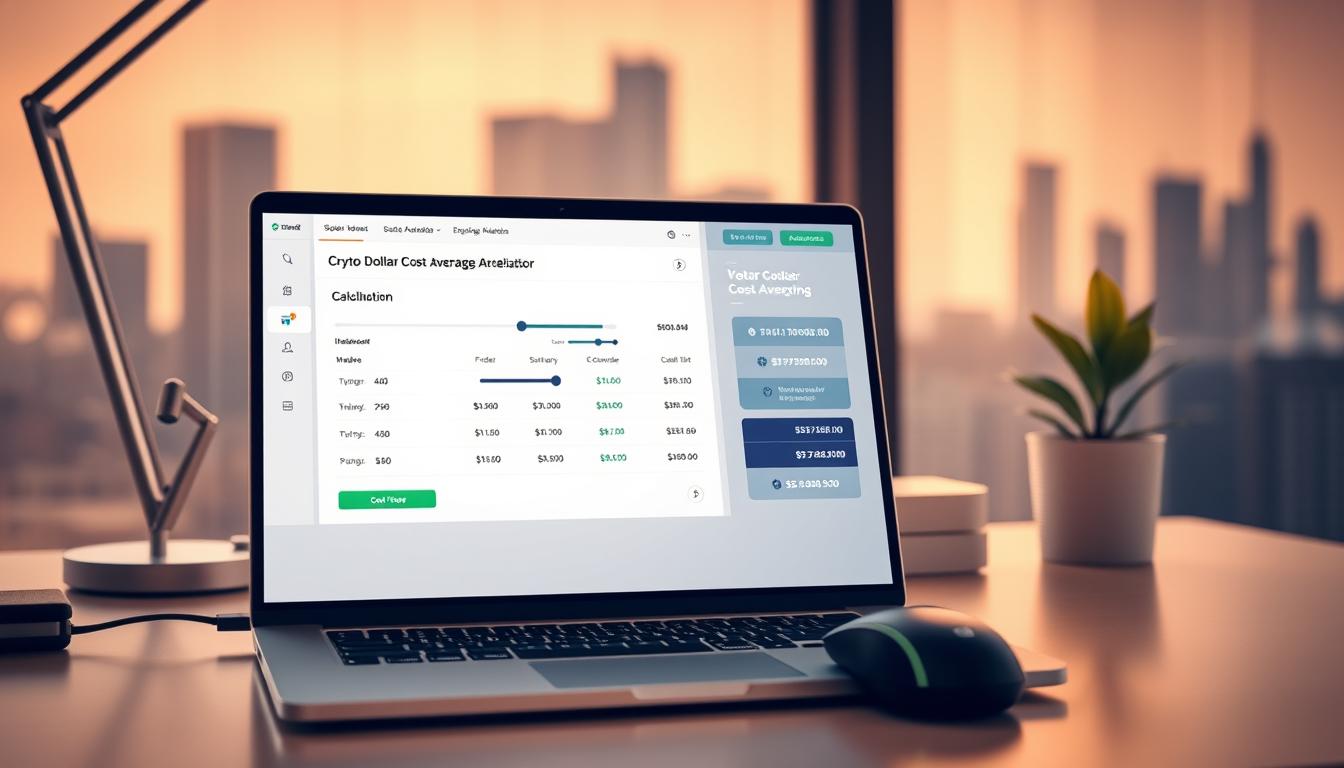Now Reading: Crypto Dollar Cost Averaging Calculator Tool – Free Online
- 01
Crypto Dollar Cost Averaging Calculator Tool – Free Online
Crypto Dollar Cost Averaging Calculator Tool – Free Online

Meet a free, browser-based calculator that helps traders and investors standardize how they determine an average price across staggered entries and exits.
This web utility supports multiple asset types — cryptocurrency, stock, and forex — so you can apply one consistent method across markets without building custom spreadsheets.
Enter quantity and order price for up to ten orders. The output is a single, actionable blended entry that helps set risk limits, take-profit levels, and breakeven thresholds before you add or reduce exposure.
The benefit: fewer manual errors and faster analysis than ad hoc Excel sheets. It complements exchange profit/loss modules by focusing on the blended average for multi-order entries and exits.
This guide is a clear, step-by-step resource for using DCA as a disciplined strategy. Ahead we show what the average calculator does, when to use it, how to enter data, a short formula demo, and key limitations to note.
What a DCA average calculator does and when to use it in today’s markets
Aggregating fills from separate orders produces a single average price that you can use for trade tickets and risk limits.

Definition
A DCA average engine computes the blended purchase price across multiple buys and sells. Enter the number of units and the price per order to get one consolidated average value.
Why it matters: the output removes manual math, reduces entry errors, and helps traders set stops and targets in volatile markets.
When to use it
- Plan staged entries or partial exits and know your breakeven before placing orders.
- Average down during a drawdown to reduce the distance to breakeven, or average up during strength to scale positions.
- Use for Bitcoin, stock, and forex positions when you leg into size or build allocations over time.
- Document fills and the number shares per order so inputs match actual executions and avoid mistakes.
| Asset | Supported Orders | Primary Input | Typical Use |
|---|---|---|---|
| BTC / crypto | Up to 10 | Number units & price | Averaging entries |
| Stock | Up to 10 | Shares & price | Build allocation |
| Forex | Up to 10 | Contracts & price | Staged exposure |
Note: averaging smooths timing risk but can raise exposure. Decide entries, number shares, and max adverse move before you fund a position.
How to use a crypto dollar cost averaging calculator tool step by step
Use a consistent input set—units, price, or fixed USD per leg—to compute a single weighted average quickly.
Inputs
Gather each order’s number of units or shares, the purchase price, any fixed amount in USD, and the total number of orders to include.
If you fund legs with a fixed amount, convert that fixed amount into units by dividing by the price for that leg.

Formula recap
The formula is simple: Average price = Total amount / Total shares (or contracts). Sum quantity × price across all legs to get the total amount, then divide by the total number of units to calculate average.
Worked example (btc)
Buy 100,000 contracts at $10,000 then 100,000 at $8,000. Total number = 200,000. Total amount = 1,800,000,000. The average price calculates to $9,000.
Interpreting results
Use the output to set breakeven, stops, and staged exits. Factor in fees and slippage so the final results match real execution.
| Metric | Leg 1 | Leg 2 | Result |
|---|---|---|---|
| Contracts | 100,000 | 100,000 | 200,000 |
| Price (USD) | $10,000 | $8,000 | Avg $9,000 |
| Total amount | 1,000,000,000 | 800,000,000 | 1,800,000,000 |
crypto dollar cost averaging calculator tool features, data considerations, and limitations
Use the sections below to understand what this utility does, where its inputs come from, and the practical limits you must accept before using results for live orders.

Core features and quick summary
This compact tool accepts up to 10 entries, computes a blended average, and previews how extra buys or partial sells shift your portfolio and breakeven.
Data sources and feeds
Market quotes come from providers like CBOE, CME Group, BarChart, and CoinAPI. Some equities and futures feeds may be delayed by 15 minutes, so always verify price before placing orders.
Limitations, risk, and best practices
- The interface does not fetch live quotes, model slippage, fees, or liquidity; add fees to the total amount for precise results.
- Charts rely on TradingView visuals; TradingView, Inc. is independent and its trademarks are owned by TradingView.
- Trading and investment involve risk and you can lose money. Past performance and simulated tests do not guarantee future results.
- Providers do not access your accounts and cannot verify outcomes. Cross-check broker confirmations and keep a position log to maintain portfolio accuracy.
| Feed | Typical Delay | Use |
|---|---|---|
| CBOE BZX | 15 min | Equities quotes |
| CME Group | 15 min | Futures quotes |
| CoinAPI / BarChart | Varies | Crypto & market data |
Recommendation: define size caps, max adverse adds, and portfolio limits before using cost averaging so results support disciplined trading and investment decisions. Read the full disclaimer for details.
Conclusion
Conclusion
Conclude with a final verification of entries: check each leg’s number of shares and price, confirm the total number and the total amount, then calculate average price to anchor your plan before placing orders.
Distributing amount over multiple purchases can temper timing risk in choppy markets, but each add raises overall exposure and may change your breakeven. Verify fees and the exact number shares so the average you use is precise.
Use the average calculator consistently to log every purchase, update the rolling average, and keep position sizing aligned with your investment strategy. The BTC example shows how a larger amount at a lower price can shift the blended average and affect exit needs.
Practical tip: document each share, date, price, and amount. Integrate this step into your wider strategy, set stops and max adds, and only commit money you can afford to lose. Apply the DCA approach thoughtfully and revisit the plan as markets and goals change.
FAQ
What does a DCA average calculator do?
It computes the average purchase price across multiple buys by dividing the total amount paid by the total number of units acquired. Use it to see your weighted entry price when you make repeated purchases at different market levels.
When should I use this approach in today’s markets?
Use it when you plan systematic buys over time to reduce timing risk, when averaging down after price drops, or when entering positions across volatile markets like Bitcoin, stocks, or forex.
What inputs are required to run the calculation?
You need the number of units or contracts bought, the price for each purchase, any fixed USD amount per order if using fixed contributions, and the total number of orders executed.
What is the formula for the average price?
Average price equals the total amount paid divided by the total number of units (shares, coins, or contracts). This gives the weighted price per unit for your position.
Can you show a simple worked example with Bitcoin?
Yes. Suppose you buy 0.5 BTC at ,000 and 0.3 BTC at ,000. Total paid = (0.5×40,000) + (0.3×45,000). Total units = 0.8 BTC. Divide total paid by total units to get the weighted entry price.
How should I interpret the results for planning entries or exits?
Compare the average entry to current market price to decide if you’re in profit or loss, and use it to size exits or add-ons. Treat it as one input in position sizing and risk management, not a guarantee of outcome.
What features do these online calculators usually offer?
Common features include support for multiple buys, fixed-amount and fixed-unit modes, CSV import, and real-time price data from exchanges and charting platforms like TradingView for reference.
Which market data sources are reliable for this calculation?
Use reputable exchanges and aggregators such as Coinbase, Binance, Kraken, or CoinGecko for spot prices. For stocks, rely on Nasdaq, NYSE feeds, or platforms like Yahoo Finance.
What are the main limitations and risks to be aware of?
Calculators assume fills at stated prices and ignore slippage, fees, and taxes. They don’t account for liquidity constraints or execution risk during fast moves. Always factor fees and realistic order fills into planning.
How do fees and slippage affect the average price?
Fees increase your total amount paid, raising the weighted average per unit. Slippage can change execution prices vs. displayed quotes—both push your real entry away from the calculated value.
Can this method be used for stocks and forex as well as Bitcoin?
Yes. The same weighted-average principle applies across asset classes—shares, contracts, and currency lots—so it’s useful for diversified portfolios and multi-asset strategies.
How often should I recalculate my average?
Recalculate after each executed order or at regular review intervals. Frequent updates help keep position tracking accurate and support timely rebalancing decisions.












